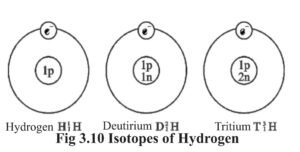What is Isotopes And Uses of Isotopes
What are Isotopes :
- According to Dalton’s Atomic Theory all the atoms of an element are similar. But later on, scientists found that this was not true. They found that the mass number of the atoms of the same element may differ. Hydrogen atom is an example which has three atomic species :
- Hydrogen 99.98%, Deutirium 0.15% and Tritium is present in very minute quantities.

- In these atoms it was observed that in the nucleus of the hydrogen, available in excess, there is only one proton in the nucleus, while in Deuterium nucleus there is one neutron along with one proton and in the nucleus of Tritium there are two neutrons and a single proton. Thus, their atomic number is one but mass number is 1, 2 and 3 respectively. From this example we can define isotope as “Atoms of the same element whose atomic number is the same but mass number is different, are known as isotopes.”
- Other examples include two isotopes of chlorine : Chlorine 35 and Chlorine 37; two isotopes of carbon : Carbon -12 and Carbon-14; three isotopes of oxygen : Oxygen-16, Oxygen-17 and Oxygen 18.
Uses of Isotopes :
- Uranium isotope is used as fuel in atomic reactor.
- Radioactive isotopes are used in treatment of various diseases. For example : Iodine -131 in goiter disease and Cobalt-60 for treatment of cancer.
- Isotopes are used to study the mechanism of chemical reactions.
- Sodium-24 is used to study the blood circulation in human beings.
Important Points :-
- The basic particles of atom are electron, proton and neutron.
- The negatively charged particles in the atom are electrons.
- The numeric value of the charge on electron and proton is the same but their sign is opposite.
- James Chadwick discovered neutrons.
- There are 6.022×1023 particles in one mole. This is known as the Avogadro number.
- The NTP volume of 1 mole of a gas is 22.4 litres.
- The formula to determine the maximum number of electrons in a shell is 2n2 .
- When the atomic number is the same but mass number is different they are known as Isotopes.
- Isobars are elements having different atomic number and the same mass number.
- There are three isotopes of hydrogen, Protium, Deutirium and Tritium.
Atomic Structure Important Questions-Answers
1. The Plum Pudding Model of atom was given by:
(a) Neil Bohr
(b) Thomson
(c) Ernest Rutherford
(d) Goldstein
Click to show/hide
Answer⇒ { B}
2. The discoverer of neutron was :
(a) C.V. Raman
(b) Rutherford
(c) J.J. Thomson
(d) James Chadwick
Click to show/hide
Answer ⇒ { D}
3. The size of atom is :
(a) 10-6 cm
(b) 10-15 cm
(c) 10-2 cm
(d) 10-8 cm
Click to show/hide
Answer ⇒ {D }
4. The number of neutrons in the Deutirium Isotope of hydrogen is /are :
(a) one
(b) Two
(c) Three
(d) Not even one
Click to show/hide
Answer ⇒ {A }
